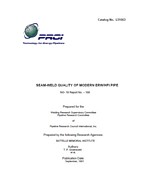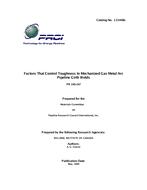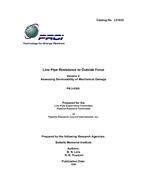Provide PDF Format
PRCI Report 198
- Seam-Weld Quality of Modern ERW/HFI Pipe
- Report / Survey by Pipeline Research Council International, 09/01/1991
- Publisher: PRCI
$248.00$495.00
L51663e
Battelle Memorial Institute
Need: Major advances have been made in recent years in the production of electric resistance-welded (ERW) and high-frequency induction (HFI)-welded line pipe, particularly in the area of automated process control procedures designed to ensure uniform, high-quality seam welds. ERW/HFI pipe produced from microalloyed, controlled-rolled steels can be obtained in larger diameters and heavier wall thicknesses than were formerly available, and with reportedly excellent seam-weld quality as well as pipe body properties. Thus, it is feasible to consider the application of ERW/HFI pipe in a number of additional applications in gas-transmission lines. The lower cost of the ERW/HFI pipe compared with double submerged arc welded (DSAW) pipe of comparable size has resulted in increased interest in the greater use of this product.
Benefit: This work was undertaken to determine whether the seam weld quality of modern ERW/HFI pipe has been improved to justify more widespread use, particularly in critical locations, with resultant reductions in construction costs. The report describes the test protocol and results from six samples ranging from X60 through X70 pipe provided by PRCI member companies. Variations in weld zone properties in one of the samples are reviewed and attributed in some detail.
Result: Five recently produced, heavy wall pipe sections fabricated using high-frequency electric-resistance welding (ERW) processes to make the seam weld and one pipe section fabricated using the high-frequency-induction (HFI) welding process were evaluated to assess the quality of the seam welds. Four of the pipes were Grade X-60, one was Grade X-65 and one was Grade X-70. Five of the pipe sections were provided from production pipe by PRCI member companies and one section was provided by the pipe producer. All of the pipes reportedly were produced from microalloyed, controlled-rolled steels, and the weld zones were post weld normalized. From the results of the evaluation of six modern heavy walled ERW/HFI pipes, the following conclusions have been drawn: (1) Ultrasonic inspection revealed no indications of defects in the seam welds from the six pipe sections. (2) The yield strengths of the weld zones of all of the pipes exceeded the specified minimum yield strengths for their respective grades (X-60 through X-70). (3) Flattened, strap tensile specimens tested with the excess wall thickness in place (Pipes 18-1 through 18-3) failed in the base metal; whereas, similar specimens with the excess wall thickness removed (Pipes 18-4 through 18-6) tended to fail in the bond line or heat affected zones. However, all the specimens from the latter joints of pipe exhibited ductile failures and no evidence of weld line defects. (4) The weld zones from five of the six of the pipes exhibited relatively low 85 percent SATT's and relatively high upper-shelf- fracture-energy absorptions as determined with Charpy V-notch specimens. For Pipes 18-1 and 18-3, the impact properties measured at the two ends of the pipe were uniform. Pipe 18-2 exhibited significant variations in impact properties at the two ends of the pipe section. (5)The weld ductility test revealed that the ratio of T-NTS to L-UTS for all of the pipes exceeded 1.0. (6)The post-weld normalizing treatments appeared to penetrate the full wall thickness of all of the pipes except for portions of Pipe 18-2. The variation in the post-weld normalizing treatment experienced by the two ends of that pipe resulted in a significant variation in the impact properties at those locations. The normalizing treatments resulted in hardnesses near the inside surface of the pipe that were somewhat lower than those near the outside surface, except for End B of Pipe 18-2.
Battelle Memorial Institute
Need: Major advances have been made in recent years in the production of electric resistance-welded (ERW) and high-frequency induction (HFI)-welded line pipe, particularly in the area of automated process control procedures designed to ensure uniform, high-quality seam welds. ERW/HFI pipe produced from microalloyed, controlled-rolled steels can be obtained in larger diameters and heavier wall thicknesses than were formerly available, and with reportedly excellent seam-weld quality as well as pipe body properties. Thus, it is feasible to consider the application of ERW/HFI pipe in a number of additional applications in gas-transmission lines. The lower cost of the ERW/HFI pipe compared with double submerged arc welded (DSAW) pipe of comparable size has resulted in increased interest in the greater use of this product.
Benefit: This work was undertaken to determine whether the seam weld quality of modern ERW/HFI pipe has been improved to justify more widespread use, particularly in critical locations, with resultant reductions in construction costs. The report describes the test protocol and results from six samples ranging from X60 through X70 pipe provided by PRCI member companies. Variations in weld zone properties in one of the samples are reviewed and attributed in some detail.
Result: Five recently produced, heavy wall pipe sections fabricated using high-frequency electric-resistance welding (ERW) processes to make the seam weld and one pipe section fabricated using the high-frequency-induction (HFI) welding process were evaluated to assess the quality of the seam welds. Four of the pipes were Grade X-60, one was Grade X-65 and one was Grade X-70. Five of the pipe sections were provided from production pipe by PRCI member companies and one section was provided by the pipe producer. All of the pipes reportedly were produced from microalloyed, controlled-rolled steels, and the weld zones were post weld normalized. From the results of the evaluation of six modern heavy walled ERW/HFI pipes, the following conclusions have been drawn: (1) Ultrasonic inspection revealed no indications of defects in the seam welds from the six pipe sections. (2) The yield strengths of the weld zones of all of the pipes exceeded the specified minimum yield strengths for their respective grades (X-60 through X-70). (3) Flattened, strap tensile specimens tested with the excess wall thickness in place (Pipes 18-1 through 18-3) failed in the base metal; whereas, similar specimens with the excess wall thickness removed (Pipes 18-4 through 18-6) tended to fail in the bond line or heat affected zones. However, all the specimens from the latter joints of pipe exhibited ductile failures and no evidence of weld line defects. (4) The weld zones from five of the six of the pipes exhibited relatively low 85 percent SATT's and relatively high upper-shelf- fracture-energy absorptions as determined with Charpy V-notch specimens. For Pipes 18-1 and 18-3, the impact properties measured at the two ends of the pipe were uniform. Pipe 18-2 exhibited significant variations in impact properties at the two ends of the pipe section. (5)The weld ductility test revealed that the ratio of T-NTS to L-UTS for all of the pipes exceeded 1.0. (6)The post-weld normalizing treatments appeared to penetrate the full wall thickness of all of the pipes except for portions of Pipe 18-2. The variation in the post-weld normalizing treatment experienced by the two ends of that pipe resulted in a significant variation in the impact properties at those locations. The normalizing treatments resulted in hardnesses near the inside surface of the pipe that were somewhat lower than those near the outside surface, except for End B of Pipe 18-2.
Related Products
PRCI PR-345-063517
In-Situ Measurement of Pipeline Mechanical Properties Using Stress-Strain Microprobe - Validation of..
$6.00 $12.00
PRCI PR-140-147
Factors That Control Toughness In Mechanized Gas Metal Arc Pipeline Girth Welds..
$198.00 $395.00
PRCI PR-003-9305
Line Pipe Resistance to Outside Force: Assessing Serviceability of Mechanical Damage..
$298.00 $595.00




